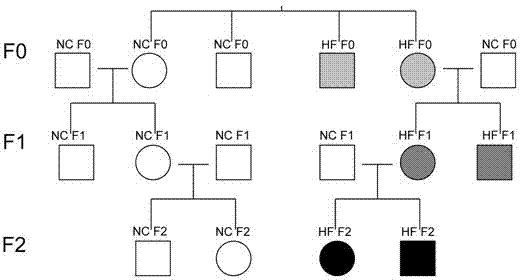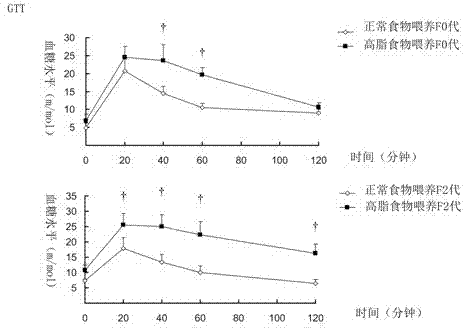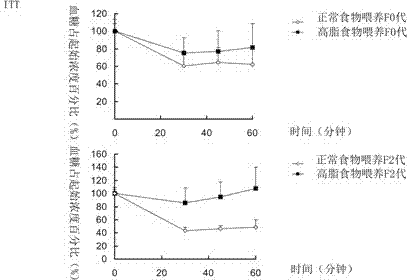Method for building mouse model with multiple-generation obesity and fatty liver pathologic change
A fatty liver and mouse technology, applied in the field of mouse model establishment, can solve problems such as inapplicable obesity and fatty liver intergenerational impact research
- Summary
- Abstract
- Description
- Claims
- Application Information
AI Technical Summary
Problems solved by technology
Method used
Image
Examples
Embodiment 1
[0030] This example takes C57BL / 6 mice as an example to illustrate the method of the present invention to establish a mouse model in which multi-generation high-fat food feeding accelerates obesity and fatty liver lesions.
[0031] Experimental materials: C57BL / 6 mice were purchased from (Animal Experiment Center of Wuhan University); mouse feed was purchased from (Wuhan Xianglong Feed); high-fat feed was mouse feed with fat added to account for 60% of the total calories of the food.
[0032] experimental method:
[0033]The C57BL / 6 mice used in this experiment were bred by the Experimental Animal Center of Wuhan University. The 4-6 week old C57BL / 6 offspring (female and male mice) fed normal food to dams were fed with normal (NC) and high-fat food (HF) respectively, that is, NC F0 (normal 1st generation) and HF F0 group (first generation of high fat). Among them, female mice were bred with male mice fed with normal food after being fed with different foods for one month, an...
Embodiment 2
[0036] Example 2: Transgenerational effects of high-fat diet on C57BL / 6 mice
[0037] All the male mice in the experimental groups were fed with different foods for 3 months, and their physiological indexes and fatty liver pathological indexes were evaluated. To study the transgenerational effects of obesity degree, insulin resistance and liver disease in this model. The index system that the present invention adopts:
[0038] Detection of various physiological characteristics of experimental mice (including body weight, blood sugar, liver weight and liver weight / body weight); HE staining method was used to evaluate the degree of hepatic steatosis in each experimental group according to certain standards; Activation levels of somatic genes in the liver.
[0039] 1. Transgenerational effects of high-fat diet on various physiological indicators of C57BL / 6 mice
[0040] After being fed with high-fat food and normal food for 3 months, the body weight and body length of mice in ...
PUM
 Login to View More
Login to View More Abstract
Description
Claims
Application Information
 Login to View More
Login to View More - R&D
- Intellectual Property
- Life Sciences
- Materials
- Tech Scout
- Unparalleled Data Quality
- Higher Quality Content
- 60% Fewer Hallucinations
Browse by: Latest US Patents, China's latest patents, Technical Efficacy Thesaurus, Application Domain, Technology Topic, Popular Technical Reports.
© 2025 PatSnap. All rights reserved.Legal|Privacy policy|Modern Slavery Act Transparency Statement|Sitemap|About US| Contact US: help@patsnap.com



